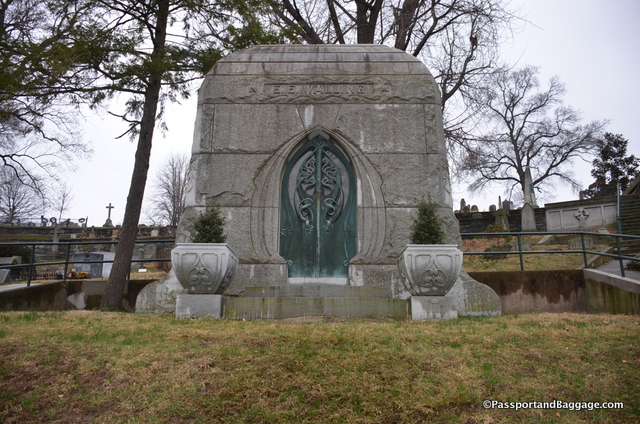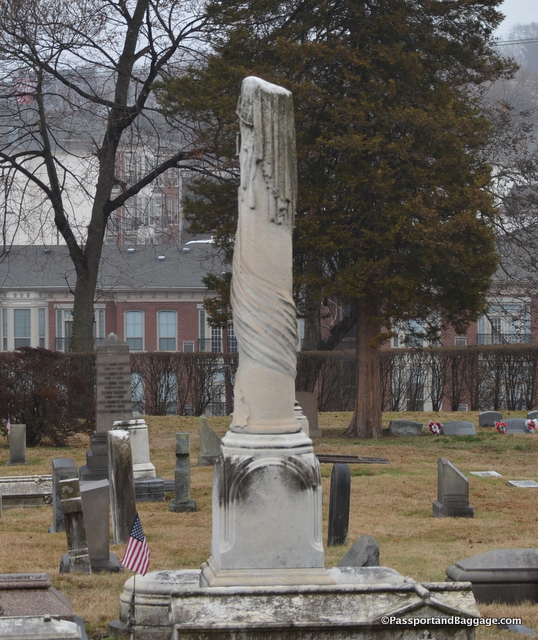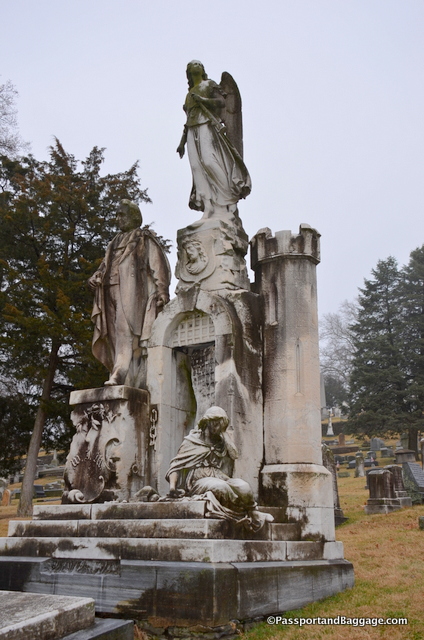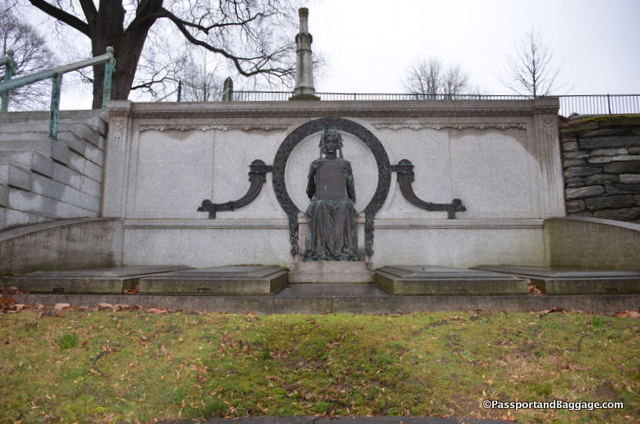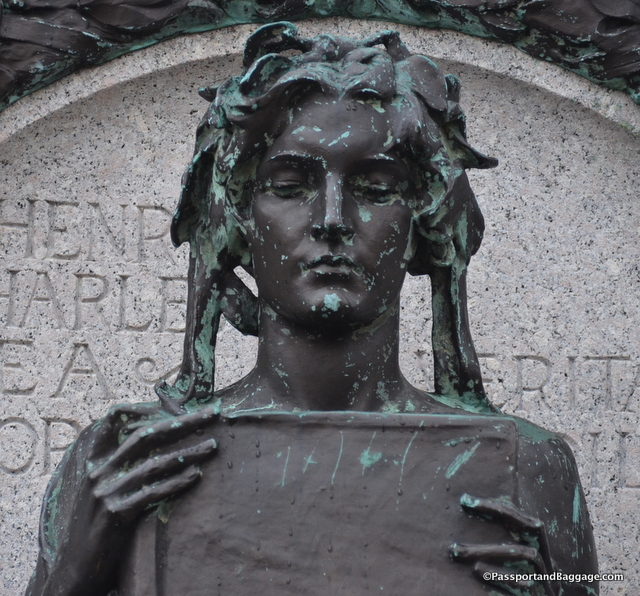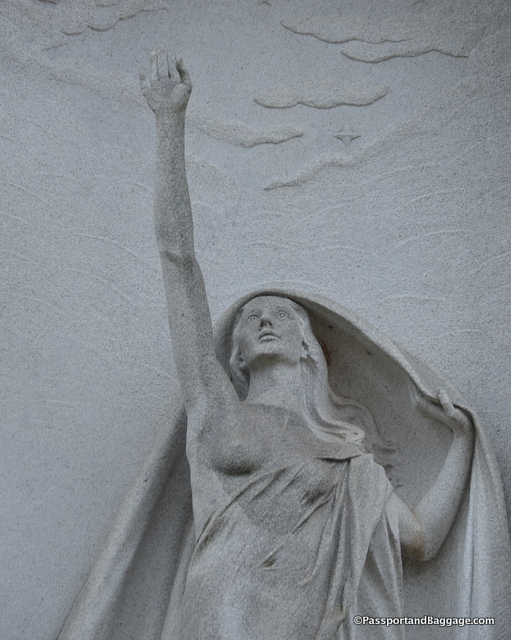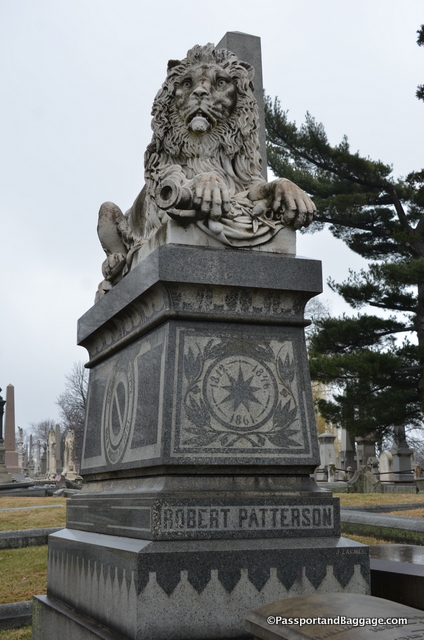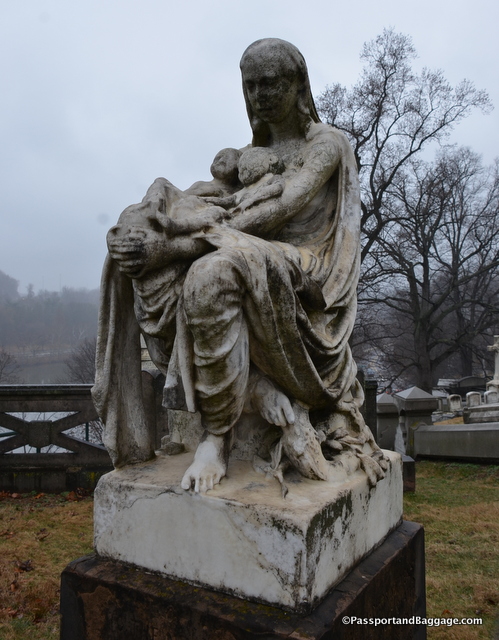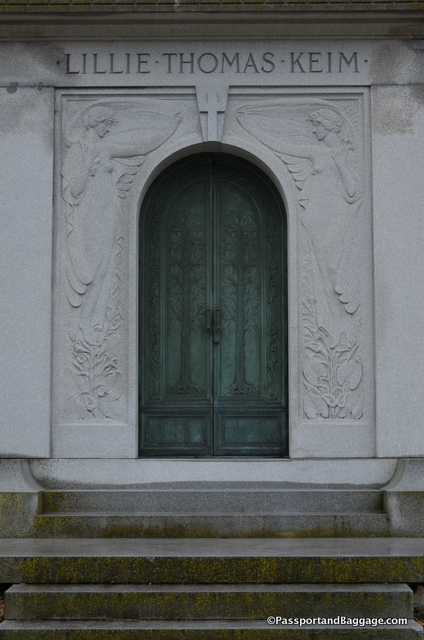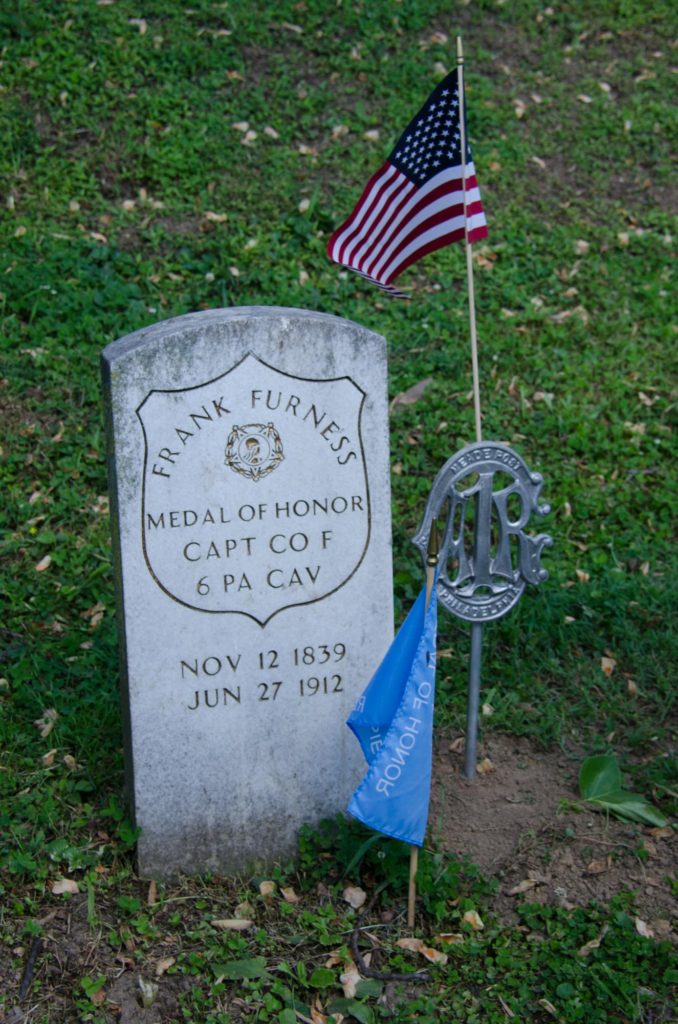Laurel Hills Cemetery
3822 Ridge Avenue
Philadelphia, PA
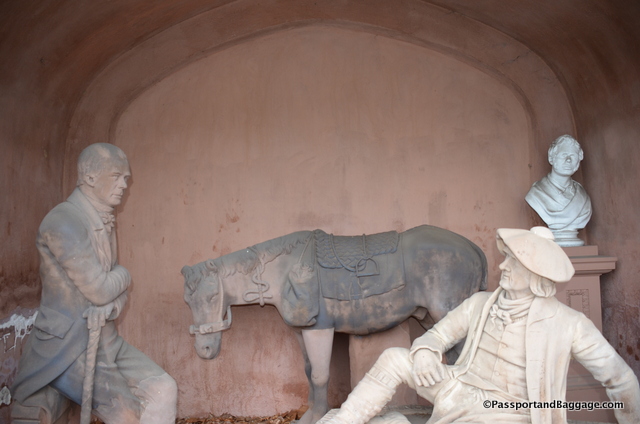
Old Mortality and His Pony. This sculpture greets you as you first enter the cemetery. It is based on the Sir Walter Scot,t 1700 novel, “Old Mortality”. Robert Patterson is the main character, an elderly Scottish Stone Mason, is shown here sitting on a marble slab. He sits talking with the image of the author Sir Walter Scott. These sandstone figures were carved by Scottish sculptor James Tom. His bust is in the right-hand corner. He sent this to the U.S. on speculation and was eventually paid $1000 for the piece. (Equivalent to $25,000 in 2000 dollars)
Laural Hills Cemetery was founded in 1836 by a group of local businessmen headed by John Jay Smith, a Quaker and librarian. The founding concepts were that it had to be situated in a picturesque location well outside the city; that it had no religious affiliation; and that it provided a permanent burial space for the dead in a restful and tranquil setting.
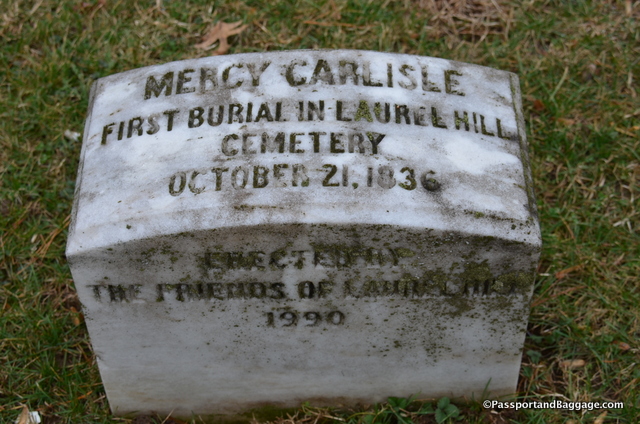
This is the first grave of Laurel Hills Cemetery – Mercy Carlisle, a pious Quaker woman. This was placed in 1990 after the original simple stone had disintegrated over time.
The cemetery was designed by Scottish architect John Notman. Notman conceived of the Cemetery as an estate garden, based in part on the English idea of planned landscapes as transitions between art and nature.
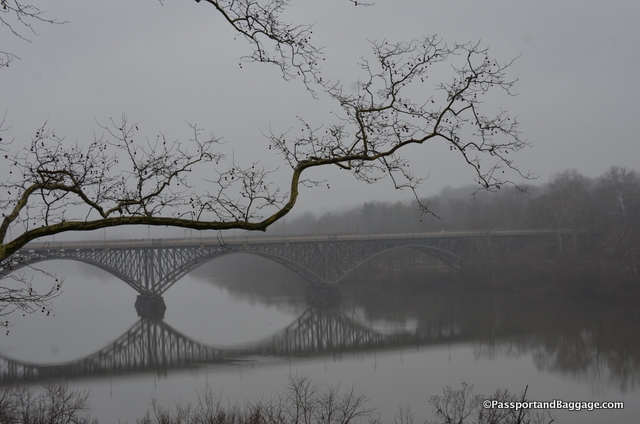 The property sits above the Schuylkill River and the views of the Schuylkill River have always been an important component of the site’s visual character and adds so very much to the experience when you visit.
The property sits above the Schuylkill River and the views of the Schuylkill River have always been an important component of the site’s visual character and adds so very much to the experience when you visit.
Today, Laurel Hill is located in the North section of Philadelphia, consists of an estimated 78-acres and is one of the few cemeteries in the nation to be designated a National Historic Landmark, a title it received in 1998.

Ivy covers this carved stone with its broken urn. Ivy was a symbol of everlasting life in Victorian cemetery symbolism.
The Victorian Age was filled with symbolism, especially when it came to death and burial. There were even books one could purchase to help you decide which symbols to use. Another unique feature of Laurel Hills are the monuments, in the 1840s the people were asked to “please don’t just erect another obelisk”, please choose something appropriate for you.
An entire funeral industry grew up around Laurel Hills Cemetery in Philadelphia, special mourning cards, clothing, and jewelry were needed as well as luxury caskets, ornately carved monuments and artificial flowers and funeral cars for railroads and trolly lines.
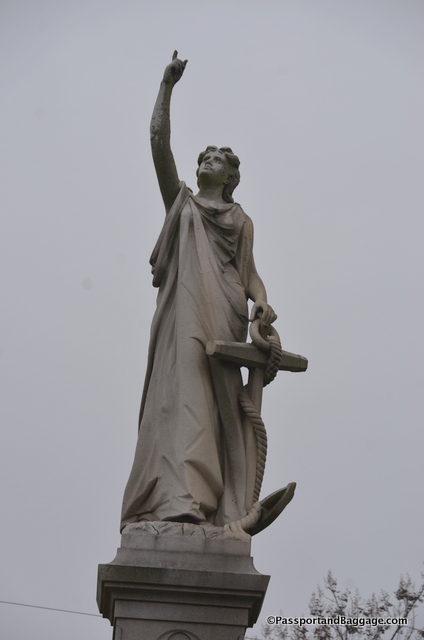
An anchor could signify a sailor or someone that made their fortune in shipping. Or it could simply be a symbol of religious salvation.
However, not all could afford these trappings, and many of the stones in Laurel Hills were mail order items. They were not necessarily inexpensive, just more affordable. Most of these were purchased from Sears Robuck and Company. Today Costco and Walmart are the largest distributors of inexpensive caskets.
Williams James Mullen is one of the more unique characters buried in Laurel Hills. He had this sculpture, with himself proudly standing there on the left, carved by Daniel Corbow, before his death, for the 1876 Centennial Exposition, the first World’s Fair in the US.
Mullen was an inventor, social activist, dentist, jeweler, and philanthropist. He is posed in front of Moyamensing Prison with its broken chains and Angel Gabriel above the prison door. It is most likely a fallen woman to the right.
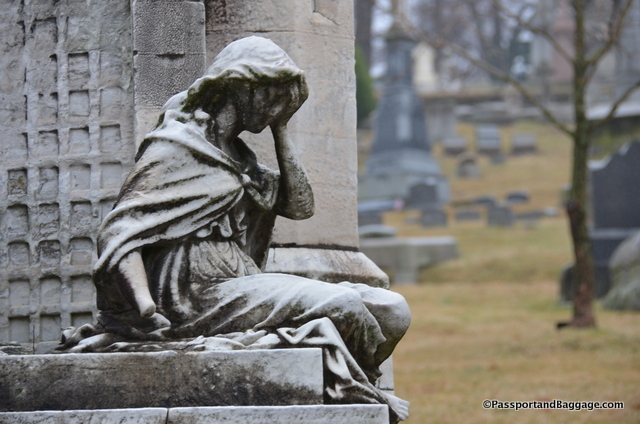 He could often be found here in the cemetery, at his plot, greeting guests and discussing the art and symbolism of his own monument.
He could often be found here in the cemetery, at his plot, greeting guests and discussing the art and symbolism of his own monument.
Mullen was a great philanthropist. He installed outdoor drinking fountains, funded homes for the poor, and lobbied for open churches so the homeless would have places to sleep. He believed in temperance and women’s rights, including opening a woman’s medical college, the first in Pennsylvania.
In 1854 Mullen became Prison Agent. He visited prisoners, helped those discharged find jobs and homes. Most importantly he helped the falsely or needlessly interned, such as a 9-year-old boy charged with the theft of an egg.
Cleo, the Greek Muse of History sits over the tomb of historian Henry Charles Lea. The sculpture is by Alexander Sterling Calder.
*
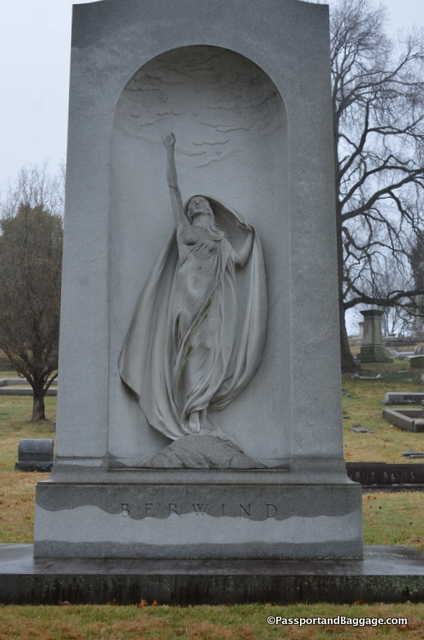 The Harry Berwind, (vice president of the Berwind White Coal Mining company) monument, Aspiration, was designed by female sculptor Harriet Whitman Frishmuth. Frishmuth studied briefly with Auguste Rodin at the École des Beaux-Arts in Paris, and for two years with Cuno von Uechtritz-Steinkirch in Berlin. She then returned to the United States and studied at the Art Students League of New York under Gutzon Borglum and Hermon Atkins MacNeil. While in New York, she worked as an assistant to the sculptor Karl Bitter, (one of the main sculptors for the Vanderbilt home in Ashville, North Carolina) and performed dissections at the College of Physicians and Surgeons.
The Harry Berwind, (vice president of the Berwind White Coal Mining company) monument, Aspiration, was designed by female sculptor Harriet Whitman Frishmuth. Frishmuth studied briefly with Auguste Rodin at the École des Beaux-Arts in Paris, and for two years with Cuno von Uechtritz-Steinkirch in Berlin. She then returned to the United States and studied at the Art Students League of New York under Gutzon Borglum and Hermon Atkins MacNeil. While in New York, she worked as an assistant to the sculptor Karl Bitter, (one of the main sculptors for the Vanderbilt home in Ashville, North Carolina) and performed dissections at the College of Physicians and Surgeons.
The woman in Aspiration is reaching towards the heavens as she releases herself from the funeral shroud.
This is one of the most photographed monuments in Laurel Hills, the Patterson Lion. The lion is surrounded by symbols of war and its paw rests on the barrel of a cannon. The sculptor was John Lackner who did many military-style sculptures around Pennsylvania.
Situated so she looks out over the Schuylkill River is the grave of Helena Schaaff Saunders and her two children, sculpted by husband and father Henry Dmochowski Saunders. Helena was a German and Henry a Pole who had fled during the Russian occupation. They met in their boarding house in Philadelphia. She was an accomplished pianist and music teacher, he a renowned sculptor. They met and married shortly after their meeting. Their first child was stillborn and buried at Laurel Hills, Helena died delivering her second stillborn child. The monument was placed here in 1859. Henry returned to Poland two years later and died in battle during the Russian occupation May 1863.
Frank Heyling Furness (November 12, 1839 – June 27, 1912) was an American architect of the Victorian era. He designed more than 600 buildings, most in the Philadelphia area, and is remembered for his diverse, muscular, often unordinarily scaled buildings, and for his influence on the Chicago architect Louis Sullivan. Furness also received a Medal of Honor for bravery during the Civil War.
The cemetery is well worth the visit, rain or shine. There are downloadable walking tours and a gift shop with incredibly knowledgeable and kind people at the front entry gate. Laurel Hill Cemetery’s gates are open: Monday – Friday 8:00am-4: 30 pm and Saturday – Sunday 9:30am-4: 30 pm.
They have many guided tours and events throughout the year. A visit to their website is a must before visiting.
